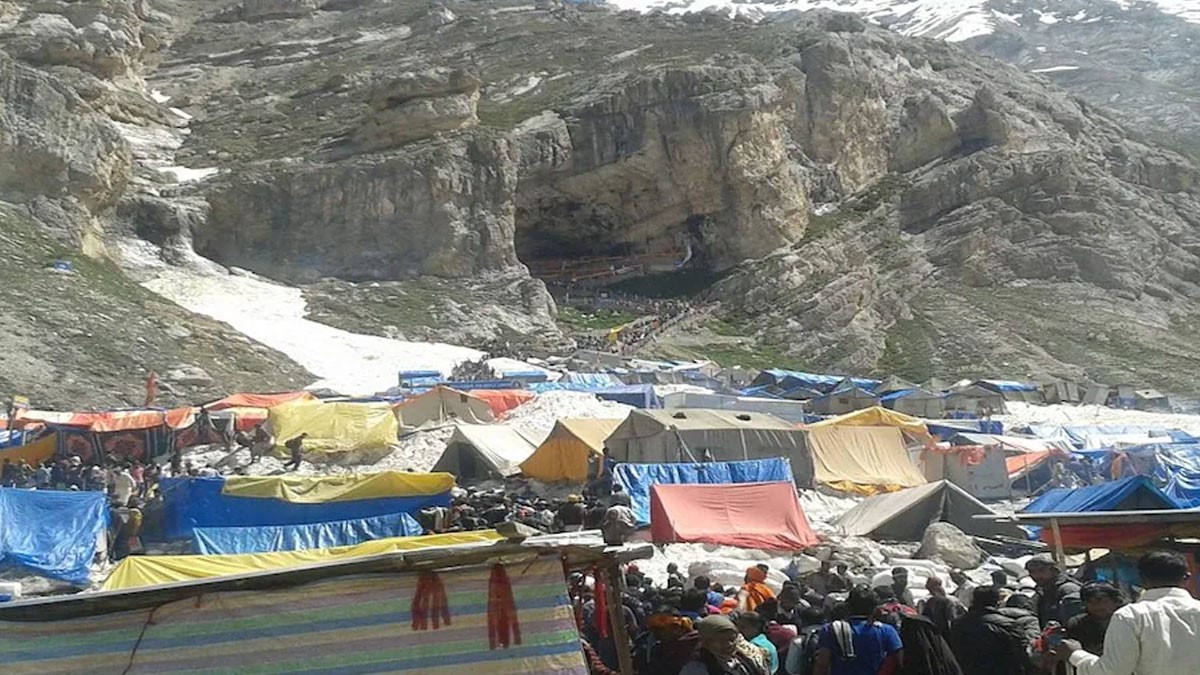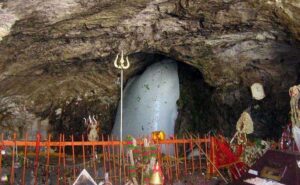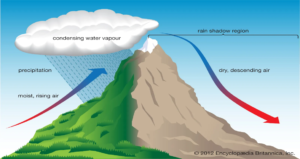
What is Cloudburst? Disaster in Amarnath, effects of flash floods
So, you have heard of cloudbursts, but what are they, exactly? A cloudburst is a sudden and heavy downpour that can cause flash flooding. Cloudburst is a natural phenomenon that occurs when a large amount of water is released from the clouds in a very short period. It can cause flash flooding and extensive damage to property and loss of life. The Amarnath cave temple is one of India’s most popular pilgrimage sites. Every year, millions of Hindus visit the temple to worship Lord Shiva. Many disasters have occurred in this temple.
In July 2017, the temple was hit by a cloudburst which caused significant damage to the premises. Several pilgrims were also injured in the incident. The cloudburst was caused by heavy rainfall in the region. The downpour lasted for several hours and led to the formation of large pools of water on the temple premises.
Similarly on July 8, 2022, major flash floods occurred due to a severe cloudburst in the Amarnath cave temple taking the lives of at least 16 pilgrims and others missing. Before we go through, let’s have a piece of detailed information about the auspicious temple.
If u want to explore the chromebooks , Then check here for guide to buy chromebooks.
Description
- Deity- Lord Shiva
- State- Jammu, and Kashmir
- District- Anantnag district
- Location- Baltal Amarnath Trek, Forest Block, Pahalgam, Jammu, and Kashmir- 192230
- Temple timings-
- It is open during Vyas Purnima to Shravan Purnima (June-August)e., 3 months
- Darshan Timings– Morning 6 am to Evening 6 pm
- Pony Ride/Trek– 6am to 3pm
- Festivals celebrated- Mahashivaratri
- Special pooja- Pratham pooja, Navagraha pooja, Chhari Mubarak
- How to reach- No direct trains to Amarnath.
- Nearest railway station- Jammu Tawi Railway Station (178km) from Amarnath
- Nearest airport- Srinagar Airport
There are 2 routes to reach Amarnath by road:
- JKSRTC Bus (Jammu and Kashmir State Road Transport Corporation) from Jammu and Srinagar to Pahalgam and Baltal
- Baltal to Amarnath (16km)- 1-2 days trek
- Pahalgam to Amarnath (35-47km)- 3-5days
- Entry fee- Free
Temple Overview

The Amarnath cave is a Hindu shrine located in the state of Jammu and Kashmir in northern India and is one of the holiest places in Hinduism. The cave is situated at an altitude of 3,888 m (12,756ft), about 141 km (88mi) from Srinagar, the summer capital of Jammu and Kashmir, and reached through Pahalgam town. Every year in July, Amarnath Yatra is organized by the State Government of Jammu and Kashmir.
Every year, thousands of pilgrims flock to the cave to offer prayers and make offerings. According to one tradition, it was originally visited by a shepherd named Buta Malik who, after his wanderings in his area, discovered the cave in which he found no images or idols but only “shivling”.
He reported this to local people who then started visiting the place with offerings for worship. The holy cave of Amarnath in the Himalayas is a place of immense spiritual significance for Hindus. The cave is home to the ice lingam, a phallic symbol of Shiva.
What is special in Amarnath? Why do devotees rush to Amarnath every year?
Amarnath cave has a naturally formed idol of Shri Amarnath Ji which resembles a Shivalinga. It is said that Lord Shiva himself revealed the secret of his origin to his wife Parvati on this spot. It is a holy site in India that is visited by devotees every year. Many of them come from far away, risking their lives on the arduous trek to the temple.
There are many reasons why devotees visit Amarnath, but the most important reason is the sacred experience of worship. It is a popular destination for devotees of Hinduism who believe that a visit to the shrine will lead to a spiritual breakthrough.
The Amarnath Yatra is said to be one of the most auspicious pilgrimages and is believed to cleanse the devotee of all their sins. The cave is open from early morning to the late evening, and pilgrims walk barefoot on a narrow pathway lined with ice and snow.
Recent cloudburst and how it impacts nature and people
On July 8, 2022, a major cloudburst occurrence devastated the holy cave area of the Amarnath, ensuing in a heavy release of water in the arm of the sea, adjoining the cave. Around 16 people died, and more than 45 people were lost after the cloudburst.
The cloudburst hurt nature and people:
- First, it affected the mental health of the tourism which caused people to refrain from visiting the temple as it is now unsafe.
- Second, water logging caused heavy damage to forests and fields nearby, and the flash floods have led to the loss of vegetation and soil on the terrace, which will impact the growth of trees and plants in the area.
- Third, pollutants released during the impact of cloudburst contaminated the environment with harmful chemicals and particles. This will also impact the local ecosystem.
What causes Cloudburst?

A Cloudburst is a type of rainstorm that occurs when a thunderstorm produces heavy rain. They are often short-lived, but the effects can be devastating. Flash flooding can result from a cloudburst, as heavy rain flows over a surface that is already saturated from earlier rain. A flash flood is a rapid flow of water that overcomes an obstacle, such as a levee or a dike, and floods an area.
According to the reports, cloudbursts occur due to rising global sea temperatures, oceans are warming up fast, as a result of which moisture-rich air is reaching the Himalayan region, resulting in cloudbursts.
Effects of cloudburst and flash floods
Flooding can have some pretty serious effects on both people and the environment. When water levels get too high, it can damage homes, businesses, and other infrastructure. Not to mention, it can also contaminate drinking water supplies and create breeding grounds for mosquitoes, which can lead to the spread of diseases.
- The flash floods have injured many people and caused many to lose their homes. Many people have also been stranded in the area and are now waiting for agencies to provide aid.
- The floods hit the base camp located outside the temple, mutilating 25 tents and 3 community kitchens where the tourists are distributed food.
- Cloudbursts are not very common, and their effects may be more evident in mountainous regions than in flat terrain.
What is a flash flood? How it is different from other types of floods
Flash floods occur due to a sudden cloudburst and massive rainfall correlated with a cyclone, thunderstorm, or due to ice melting over ice sheets or snowfields which might be dangerous for nature and other people. Flash floods can be extremely hazardous, instantly turning a babbling brook into a thundering wall of water that sweeps away everything in its path. It arises when the ground is unable to soak the water as quickly as it drops down. The flood rapidly gets abated, but while it lasts can be expeditious and dangerous. It has caused extensive damage to the temple and has disrupted many people’s lives.
It occurs due to 2 reasons:
- A sudden slump of a natural ice or detritus dam.
- A human structure like a semisynthetic dam.
Do you know the difference between a flash flood and a regular old flood?
No? You’re not alone. Many of them are unaware of the difference, and that’s because flash floods are a relatively new phenomenon. Finally, we’ll break down the differences between flash floods and other types of floods.
So, what sets flash floods apart from other kinds of floods? Quite simply, it’s the speed at which the flooding occurs.
- Flash floods can develop in just a few minutes, often catching people by surprise. They’re additionally more dangerous, as the fast-moving water can quickly sweep away cars and people.
- They are more likely to occur in areas that are already susceptible to flooding, such as low-lying areas or river basins.
- Another key difference is the cause of the flood. Flash floods are usually caused by intense rainfall, whereas river floods are caused by the overflowing of a river.
- Flash floods are additionally more dangerous than other types of floods as a result they can happen suddenly without warning.
- A tsunami, on the opposite hand, could be a sort of flood that’s usually caused by an earthquake or a volcanic eruption.
If you are affected by a cloudburst, follow these 6 steps to guard yourself and your family;
It is vital to know what to do if you are caught in the middle of a cloudburst. Here are a few steps to help you get through the storm safely:
- If you are in an area that is flooded or has standing water, move to a higher floor or outside.
- If you are in an underwater area, stay put and stay calm. If you cannot leave the area, curl up in a ball and protect your head and neck from contact with water.
- If you are within the place, keep within till the storm passes. If you are outside, stand back from power lines and trees, and get shelter in a building if you’ll be able to.
- Stand back from felled power lines.
- Stay away from detritus.
5 tips and extra precautions to be taken for the Amarnath yatra
If you are planning on making the trek to Amarnath Cave, here are a few tips to make your expedition as safe as feasible. While the journey is worth it, take extra precautions to protect yourself from the elements and altitude sickness. Follow these 5 tips, and you will be on your way to an unforgettable experience!

- Get informed
Start by learning as much as you can about the pilgrimage. Make sure you understand the route, what to expect, and what to bring. The Amarnath Cave website has wealth of information, and there is also plenty of helpful resources available online. Familiarizing yourself with the journey will help make you better prepared for what to expect.
- Stay Hydrated, protect against the sun
The trek to Amarnath Cave is a long one, and it is important to stay hydrated along the way. Make sure to drink plenty of water, and bring along a water bottle to refill if needed. The sun can be intense at high altitudes, so it is important to protect your skin by applying sunscreen lotion.
- Dress in Layers
The weather can be unpredictable in the Himalayas, so it is important to dress in layers. Wear clothing that can be easily adjusted to match the changing temperatures.
- Safety measures for emergency
Always carry a first aid kit in case of emergency circumstances, there is no guarantee for the occurrence of natural events, it can be anytime and anywhere, so be well prepared with all your safety measures. Take extra care if you are driving in the mountains.
- Be with your group
For a better journey experience, be with your group, hence you will get proper guidance for trekking, and you will not have the fear of losing yourself. Be informative about your group, in case you are lost you can easily take the help of the local police or security and inform them so that they can reconnect you with your group. In case anyone is missing, take the instant help of the police and make an announcement.
Points to be noted:
- No worries if you are unable to travel to the holy place, you can still have a darshan of Lord Amarnath and get blessings from him.
- Devotees can avail the facility of ONLINE DARSHAN, pooja, havan, and prasad.
- Helpline No. 14464
Conclusion
We must learn from this incident and do everything possible to prevent such incidents from happening again in the future. Do visit the temple and take precautions and safety measures with you. The local police are protective and helpful. We have given the information about the cloudburst and flash floods that occurred in the temple and how it destroys the life of the people and nature, so be careful if you are planning to visit the temple take safety measures, and be informative.
Nearby places to visit:
Vaishnodevi Temple in Bhavan, Katra, Jammu, and Kashmir- 182301
Shiv Khori Temple in Ransoo village (140km) from Jammu
Mamleshwar Temple in Pahalgam, Kashmir





Comments (1)
Comments are closed.